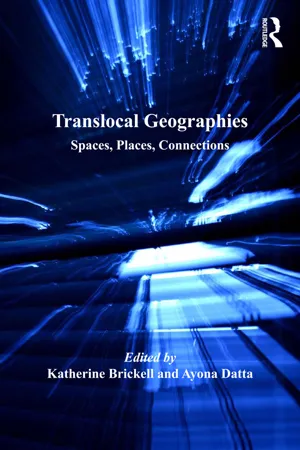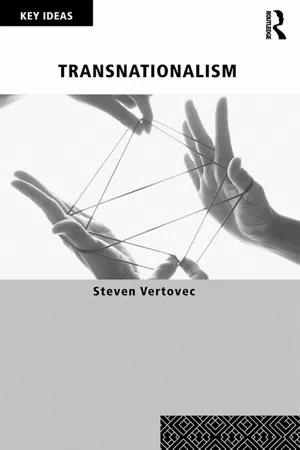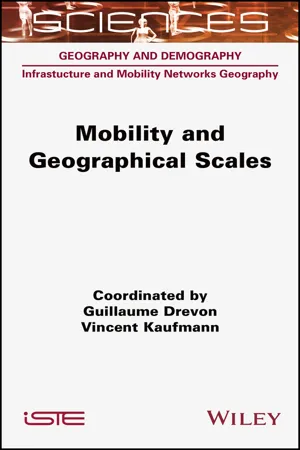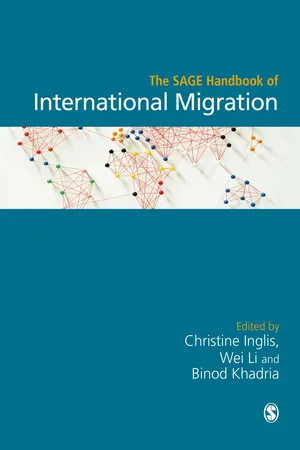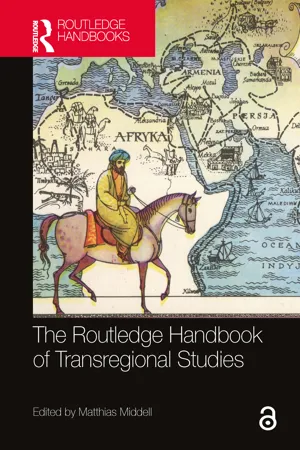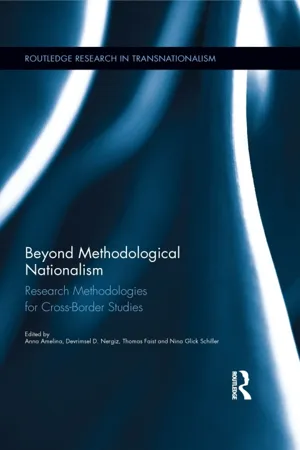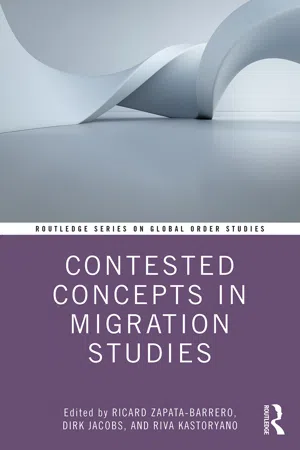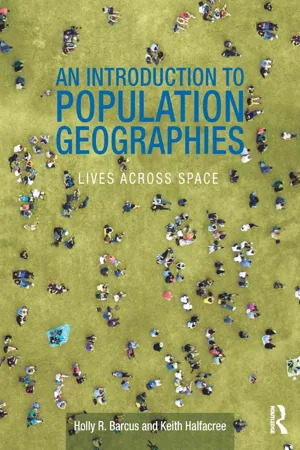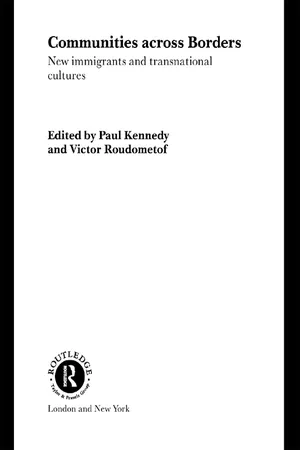Geography
Transnational Migration
Transnational migration refers to the movement of people across national borders, often involving the crossing of multiple countries. It is characterized by the maintenance of social, economic, and cultural ties across these borders, leading to the formation of transnational communities. This phenomenon is influenced by factors such as globalization, economic disparities, and political instability, and has significant impacts on both sending and receiving countries.
Written by Perlego with AI-assistance
Related key terms
Related key terms
1 of 4
Related key terms
1 of 3
10 Key excerpts on "Transnational Migration"
- eBook - ePub
Translocal Geographies
Spaces, Places, Connections
- Ayona Datta, Katherine Brickell, Katherine Brickell, Katherine Brickell(Authors)
- 2016(Publication Date)
- Routledge(Publisher)
Overcoming Barriers: Human Mobility and Development) . These migrants are not transnational; rather translocal, but they also move across different places and equally take a range of decisions around moving. But these migrants often fall under the rubric of other forms of migration such as rural-urban or regional migration, which are often located within the discipline of development geography.This then is our point of departure. In this book we retrieve translocality from within the confines of transnationalism to examine local-local connections in their own right and without privileging the national. We suggest that the nation-state is less than a potent vessel for understanding migrant identifications, and therefore the subsuming of translocality within transnationalism implies ‘that the only things we are interested in are the dynamics across or beyond nation states, or within the (nation-) state system’ (Levitt and Khagram 2004: 5). Translocal geographies, as we examine in this book then, includes migration in all its forms; it includes highly mobile and elite transnationals as well as those who are ‘immobile’ and often viewed as parochial; and it includes a focus on local-local movements that are part of a continuum of spaces and places related to migration.There is another significant consequence of examining translocality in its own right. It allows us to examine the local as situated across a variety of scales – body, home, urban, regional or national; which means that translocal geographies can becomes a set of local-local negotiations across these different scales. This resonates with Ley’s suggestion that, ‘There is a need to re-incorporate other scales, including the regional, the national and the supranational but not yet global, such as the European Union and other continental-scale trading networks. … Moreover, jumping scales is an important necessity both in explanation and in political practice’ (Ley 2004: 155). In order to locate translocal geographies across scales, ‘metaphors of domination need to be mingled with metaphors of vulnerability, images of global reach with those of parochialism, a discourse of detachment with one of partisanship’ (Ley 2005: 157). Taking into account such diversity of scales and the spaces therein, we can examine migrants’ locations within simultaneous positions of power and powerlessness in different places; migrants’ access to different spaces of social networks and capital; and migrants’ embodied and material locations across different places that are not necessarily about transnationalism but rather about translocal geographies of movement. - eBook - ePub
- Steven Vertovec(Author)
- 2009(Publication Date)
- Routledge(Publisher)
1INTRODUCTION
TRANSNATIONALISM, MIGRANT TRANSNATIONALISM AND TRANSFORMATION
Today transnationalism seems to be everywhere, at least in social science. That is, across numerous disciplines there is a widespread interest in economic, social and political linkages between people, places and institutions crossing nation-state borders and spanning the world. The expansion of transnationalism as a topic of study has been tracked by Gustavo Cano (2005). Cano examined publications that were keyworded ‘transnational’ or ‘transnationalism’ in the Social Science Abstracts Database and saw an increase from a mere handful of articles across the social sciences in the late 1980s to nearly 1,300 such keyworded articles by 2003; almost two-thirds were published between 1998–2003. As any current internet search will reveal, this expansion of interest is evident in a rapidly increasing number of publications, conferences and doctoral projects within the disciplines of sociology, anthropology, geography, political science, law, economics and history, as well as in interdisciplinary fields such as international relations, development studies, business studies, ethnic and racial studies, gender studies, religious studies, media and cultural studies. And as particularly detailed in the bulk of this book, such interest is growing in migration studies too.It is not a coincidence that the growth of interest in transnationalism – or sustained cross-border relationships, patterns of exchange, affiliations and social formations spanning nation-states – parallels the growth of social scientific interest in globalization over the same period (see Guillén 2001). Facilitated, but not caused, by improved transportation, technology and telecommunications, globalization has entailed the increasing extent, intensity, velocity and impact of global interconnectedness across a broad range of human domains (Held et al. - eBook - ePub
- Guillame Drevon, Vincent Kaufmann(Authors)
- 2023(Publication Date)
- Wiley-ISTE(Publisher)
This migrant-centered perspective and the development of new perspectives on borders are part of a general critique of the “methodological nationalism” prevailing in social sciences. For Dumitru (2014), this approach refers to “a cognitive bias” that consists in “understanding the social world by taking the nation-state as the unit of analysis”. Focusing on the networks and movements of migrants rather than their settlement allows us to go beyond the statocentric perspective that Sayad already denounced. This critique is developed particularly through the concept of “transnationalism”, a term coined in the United States mainly by anthropologists Bash et al. (1992). According to these authors, transnationalism refers to “the processes by which immigrants build social fields that link together their country of origin and their country of settlement” (p. 1).For Glick-Schiller (1992), the transnational links established by migrants are of a different nature and intensity than those built by economic immigrants whose flows have marked the industrialized countries since the 1950s. Understanding the migrant as an autonomous actor then requires a new theoretical paradigm. In fact, “transmigrants” do not simply rebuild an immigrant community in the country of arrival, but maintain relations with the country they have left by various means that depend on their origins and their degree of politicization. They maintain not only family but also economic, political, religious, and organizational ties that bring several societies together into a single “transnational social field”. In connection with transnationalism, the concept of migratory “circulation” (Tarrius 1992) seeks to capture the displacements that are characterized by the absence of a single, fixed place of residence. It invites us to focus on “the practices and initiatives of people, on the routes and spaces they travel” (Berthomière and Hily 2006).This new interpretation of migration coincides with the mobility turn that marked the social sciences in the 2000s. This scientific paradigm, which is notably supported by Sheller and Urry (2006), maintains that society can only be thought of in terms of a system of circulations: migrations, daily mobilities, tourism, but also flows of goods, capital, and ideas. However, many studies have criticized and qualified the idea of a shift to a regime of “generalized mobility” (Bourdin 2004). On the one hand, increased mobility brings into play a set of unevenly distributed skills and dispositions (Kaufmann 2002). On the other hand, the setting in motion of the world responds to a set of injunctions carried by a neoliberal ideology, translated particularly in professional circles in the form of individual projects (Boltanski and Chiapello 2002; Colombi 2016). The “mobile elites” or “highly skilled migrants” (Beaverstock 2005) embody, from this point of view, a population valued for its open-mindedness, its dynamism, and its entrepreneurial motivation (Favell 2008). Sedentary life, on the other hand, is negatively connoted and associated with the deprivation of economic, cultural, and social resources (Orfeuil and Ripoll 2015). - eBook - ePub
Migration Theory
Talking across Disciplines
- Caroline B. Brettell, James F. Hollifield, Caroline B. Brettell, James F. Hollifield(Authors)
- 2022(Publication Date)
- Routledge(Publisher)
Geography is a discipline closely associated with maps and spatial reasoning. Maps, especially thematic ones, challenge us to visualize spatial distribution of phenomena across space and over time at various scales. Anything that is unevenly distributed is eminently mappable and thinking in maps invites us to consider spatial arrangements. The varied movement of people has been an irresistible subject for geographical inquiry and theorization since the inception of the modern discipline. Why is a cluster of migrants located in one place and not another? How are clusters linked through networks and how do these distributions influence space and place? What structural or environmental forces are driving human mobility? Mapping forces one to select a scale of analysis; consequently, geographers have a proclivity to shift scales, from the local to the global, and even jump scale when necessary. Not limited to any single container of convenience, such as the territorial state, geographers consider various socio-legal containers when theorizing about migration from neighborhoods, to cities, to meta-regions such as Europe or Africa. Geographic scholarship is increasingly interested in how these containers are enforced, deformed, and reconstituted in response to migration. Finally, geography is concerned with a deeper understanding of context and placemaking, seeing space as layered with information such as: the physical environment, the ethnic composition of residents, and their socioeconomic well-being. Human mobility is often a response to and a catalyst for these layers, and thus the social and environmental contexts of areas of departure and reception invite geographical theorization.This chapter will consider some of the foundational theories that shape geographical understandings of migration and human mobility. It argues that, as a discipline, geography has a long-standing thematic interest in human migration, because the movement of people “continually disrupts and remakes geography, as spatial linkages and interconnections both form and dissolve when people move” (Skop 2019: 108). As international migration has intensified since the 1990s, geographic scholarship that empirically demonstrates these flows and theorizes their impact has steadily increased (Price and Benton-Short 2008; King 2012; Czaika and de Haas 2014; Winders 2014; Yeoh and Ramdas 2014; Ehrkamp 2017, 2019, 2020; Collins 2020). Theoretically, geographers have worked across disciplines, and have modified existing theories, as well as inserted innovative theoretical perspectives and methodological approaches. At the core of much of this work is a profound interest in explaining spatial patterns and human networks, as well as a sensitivity to scalar shifts and bordering practices. Human geographers offer theoretical insights about the migrant experience, limits to human mobility, practices of placemaking, development, and integration, as well as the intersectionality of gender, race, and class in understanding migration (Silvey and Lawson 1999; Carling 2002; van Riemsdijk 2014; Yeoh and Lam 2016). Because of geography’s inclination to examine the relationship between society and environment, there is also a growing research interest in the environmental drivers of migration, especially connected to climate change (Hugo 1996; Piguet 2010; Piguet, Kaenzig, and Guélat 2018; Jockish et al. 2019).Within the sub-disciplines of geography, population geographers have an obvious interest in migration. The International Journal of Population Geography, later renamed Population, Space, and Place - eBook - ePub
- Christine Inglis, Wei Li, Binod Khadria, Christine Inglis, Wei Li, Binod Khadria(Authors)
- 2019(Publication Date)
- SAGE Publications Ltd(Publisher)
8 Geography and Migration Emily SkopIntroduction
This chapter considers how geographers take account of the inherently spatial phenomenon of migration. First, the chapter discusses the unique spatial perspective that broadly makes geography an ideal discipline for studies of migration, including utilizing core spatial concepts like space, place, networks, movement, scale, and territory, as well as the discipline's methodological diversity, and its tendency towards interdisciplinary engagement. Second, the chapter focuses on the way the discipline of geography has conceptualized and examined migration through a discussion of key theoretical framings within the field, including neoclassical spatial analysis, the socio-spatial lens, and the geopolitical turn. Third, the chapter reflects on the major developing trends and debates in the discipline of geography with regards to migration studies, with an eye towards future research and interdisciplinary perspectives, with special attention given to ‘crisis’ migration as well as the mobilities paradigm.The Discipline of Geography
Migration – a process that evolves over space and time – involves the continual reshaping of space as persons move. Migration has risen dramatically in the past two centuries, and the result is constant transformation and dislocation, which in turn has prompted significant attention to the phenomenon by geographers. Indeed, geographers are especially interested in migration because it continually disrupts and remakes geography, as spatial linkages and interconnections both form and dissolve when people move. The socio-spatial patterns, causes, and consequences of migration are innumerable and include complicated, multi-scalar phenomena, all of which are studied by geographers.The geographical lens encourages a unique spatial perspective when it comes to the study of migration. While definitions have been highly contested and subjected to pages of debate, below are some generalities that pertain to migration studies. Among its most important differentiating features, the geographical lens (and the spatial perspective more specifically) is: - eBook - ePub
- Matthias Middell, Matthias Middell(Authors)
- 2018(Publication Date)
- Routledge(Publisher)
As a missing link between internal and international migration, the transregional approach to migration aims to broaden the conceptual research perspective to better capture the spatial diversity of changes of migration systems as well as the complexity of migration patterns, which include forms of mobility combining overlapping elements of temporary, permanent, and circular migration (see Göler and Krišjāne 2013, 2016). In addition, a transregional perspective on migration might not only be beneficial for the analysis of historical migration dynamics during past centuries when states, immigration restrictions, and migration control systems were of limited importance. The ‘scholarly disregard for the regionality of moves’ even concerning contemporary migration appears surprising given the fact that the vast majority of migrants – for instance, on the African continent – migrate intra- and interregionally (Hoerder 2012: 79).Therefore, recent scholarly work calls for a departure from the common view of migration as taking place between nation-states and suggests considering specific regional frames, such as labour markets, as spaces of migrants’ interactions. Since migrants move and interact on national as well as subnational levels to mitigate risks and vulnerabilities, it needs to be acknowledged that their mobility transgresses and questions rigid concepts. As such, migration research needs to think beyond the national dimension and state territories as the predominant spatial scales of analysis when investigating different forms of mobility. A new approach that includes transnational, transregional, and translocal perspectives might comprehend, as Hoerder puts it, ‘the multiple internal and cross-border spaces created by migrants’ (2012: 83).ConclusionDespite – or precisely because of – the semantic and conceptual similarities between the terms exile, diaspora, and transmigration, one important task of contemporary migration research is to point out the key differences between them as important categories in this field of research. In addition, it is worthwhile to examine the potential of transregionalism in migration research and to think beyond categories of borders and nations. A typology is needed that is not – and cannot be – rigid. Through its flexibility, this typology would allow theoretical and empirical migration research to better represent and understand the diversity of global movement experiences and to meet the challenge of a nuanced understanding of historical and contemporary migration phenomena. - eBook - ePub
- Anna Amelina, Devrimsel D. Nergiz, Thomas Faist, Nina Glick Schiller, Anna Amelina, Devrimsel D. Nergiz, Thomas Faist, Nina Glick Schiller(Authors)
- 2012(Publication Date)
- Routledge(Publisher)
Part I Researching International Migration after Redefining Space and MobilityPassage contains an image
2 Transnationality, Migrants and Cities
Nina Glick SchillerA Comparative Approach1DOI: 10.4324/9780203121597-3To speak of transnationality and the city is to challenge the paradigms that underlie most urban research and public policy. The term transnationality places cities within the synergies and tensions of the mutual construction of the local, national and global. It also situates migrants and their transnational connectivities fully within the forces that are constitutive of the urban . Sometimes used as a synonym for what I would call transnational social fields and others call transnationalism, the term transnationality can more usefully be employed to signal the simultaneous social-cultural, economic and political processes of local and cross-border participation, soci-ality, membership, connection and identification. This reading of the term transnationality emphasizes the concept of nationality embedded yet problematized by the term. Transnationality invokes both processes of social connection and belonging (Ribeiro 1994 ). Conceptualized in this way, the term makes reference to a world judicially divided into states that claim legitimacy to power through claims to represent a nation, while also highlighting the border crossing processes that are foundational to all modern nation-state building processes. By theorizing transnationality and the city, this chapter contributes to the growing understanding that scholars need to situate cities and their diverse inhabitants in multiple, interpenetrating scales of relationality. These interpenetrating dimensions of connection and identification are produced and reproduced within both time and space (Amin and Graham 1997 ; Massey 2005 ; Mitchell 2003 ; Smith 2001 - eBook - ePub
- Ricard Zapata-Barrero, Dirk Jacobs, Riva Kastoryano, Ricard Zapata-Barrero, Dirk Jacobs, Riva Kastoryano(Authors)
- 2021(Publication Date)
- Routledge(Publisher)
In this chapter, I discuss these three ways of understanding the pair of concepts in a slightly different order. The second section starts with the most general notion of migration and mobility as human movement in time and space. In this natural science approach where background social contexts are abstracted away, the two concepts appear initially to be perfect synonyms but can also be usefully distinguished by referring to different patterns of movement. The third section focuses on the social context of modernity. It proposes that migration can be understood as a specific type of movement that is defined by the crossing of territorial borders and explores three conundrums concerning the relation between borders and migration. When migration is perceived in relation to territorial borders, the size of territory and the shifting of borders have paradoxical implications for the measurement of migration. These puzzles lead to a more general lesson that macro-level studies of migration need to assume a stable background of bounded territories and sedentary societies, whereas micro-level studies may adopt a mobility perspective by taking migrants’ life courses as the basic unit of analysis. The fourth section considers mobility as freedom of movement across and within borders and suggests three pathways to enhanced free movement under conditions where states retain immigration control powers. The chapter concludes with a brief discussion of the new mobilities paradigm, the emergence of which is closely associated with economic globalization, technological, and cultural changes around the turn of the millennium. These have greatly increased the volume, distances, and paces of geographical movements and have led mobilities scholars to question statist perspectives that dominate in migration studies. We should, however, not assume that this is an irreversible trend. A possible decline in geographic mobility in the next decades is likely to affect also the distinct conceptual perspectives of migration and mobilities studies.2 Human movement in time and space
Unlike most plants and fungi, humans are animals that need to move around in order to find food and partners for procreation. Moreover, humans belong to a group of animals that have evolved to adapt to very different climates. However, unlike for some fish, birds, or whales, it was until very recently impossible for individual humans to move over very long distances. The great migration of homo sapiens out of Africa to other continents happened over many thousands of years and as a collective movement of groups rather than individuals. Yet daily and seasonal patterns of smaller-scale movements were part of the common experience of humans until the onset of the agricultural revolution. Hunters and gatherers led nomadic ways of life that – unlike those of hypermobile people in today’s societies – were shared within closely knit kin groups and tribes. Humans have in this specific sense evolved to be migratory animals. - eBook - ePub
An Introduction to Population Geographies
Lives Across Space
- Holly R. Barcus, Keith Halfacree(Authors)
- 2017(Publication Date)
- Routledge(Publisher)
CHAPTER 5Placing human migration5.1 INTRODUCTION: DEFINING MIGRATION
5.1.1 What is migration?
Migration remains the most widely studied and examined element within Population Geography (Boyle 2003, 2004). Moreover, whilst Geographers have played a pivotal role in shaping our contemporary understanding of it, the topic is of interest to numerous academic disciplines, including Demography, Sociology, Political Science, Economics and Anthropology (Brettell and Hollifield 2008a). In this respect, approaching migration as it occurs within the life course has considerable potential for bringing together a scattered body of scholarship often fragmented by “disciplinary partitioning” (Olwig and Sørensen 2002: 7).But what exactly is migration? Initially put, as in a recent textbook, it is “the movement of people to live in a different place” (Holdsworth et al. 2013: 96) or a “permanent change in residence.” It is residential relocation. Or, as expressed in UK and US censuses, a migration is deemed to have occurred when one’s “usual address” has changed within the last 1 or 5 years, respectively (ONS 2013; USCB 2013). Simple, then, one might think! However, as Holdsworth et al. (2013: 98) also noted, careful consideration of these definitions immediately raises a host of questions: what precisely is meant by “different place,” “live in,” “permanent,” or “usual address”? Consequently, by the end of the present chapter, “migration” will have been demonstrated to be at least as complex and multi-dimensional a concept as Chapter 4 revealed “fertility” to be.Starting with the idea of “different place,” the type of areal unit(s) involved in a migration is an initial important consideration when defining it specifically. A crucial starting point is whether a political boundary is crossed during a move. For example, an individual could move from one county to another within the same US state or from one state to another. Both moves are conventionally described as intra-national or internal migration, because neither involves leaving the US. In contrast, a move from the US to Canada, crossing an international border, is an international migration - eBook - ePub
- Paul Kennedy, Victor Roudometof(Authors)
- 2003(Publication Date)
- Routledge(Publisher)
Gastarbeiter or illegal immigrants. This interpretation flows from Anderson’s (1983) earlier work – with the important difference that now place of residence and locality have become disjoined.Obviously, none of the above is meant to refute the fact that many transnational communities have been born out of the experience of social injustices, global inequalities and chronic insecurities. Global economic restructuring, the post-1989 capitalist boom and the ascendancy of neoliberal economic policies have further accentuated such experiences. Migrant encounters with radicalised social exclusion in host countries have further intensified the exposure of people everywhere, but especially in poor countries, to conditions of great economic and social uncertainty (Goldring 1998; Smith and Guarnizo 1998). Thus, as Schiller et al. (1992: x) remark, ‘Transnational Migration is shaped by … the encompassing global capitalist system’ and ‘is becoming increasingly a global phenomenon as populations in capital-dependent countries are everywhere forced to migrate to centres of capital in order to live’.Indeed, membership and participation in such migrant or diasporic communities have long provided strategies of escape from poverty, discrimination and oppression for both individuals and their families – even if many kin remain behind in the home village (see, for example, Chan 1997; Smith 1998). Migrant communities have often offered a way of vitiating the worst aspects of poverty and oppression experienced by entire regions, countries or peoples (for example, Cohen 1997). In Portes’s (1997, 2000) formulation, the transnational communities of the new immigrants represent a process of empowerment for the underprivileged groups – or what he calls ‘globalisation from below’ to be sharply contrasted with ‘globalisation from above’, i.e. global financial integration and the spread of capitalism worldwide.
Index pages curate the most relevant extracts from our library of academic textbooks. They’ve been created using an in-house natural language model (NLM), each adding context and meaning to key research topics.
Explore more topic indexes
Explore more topic indexes
1 of 6
Explore more topic indexes
1 of 4
